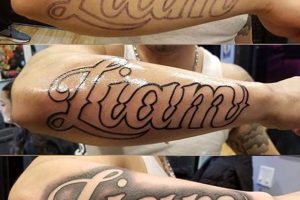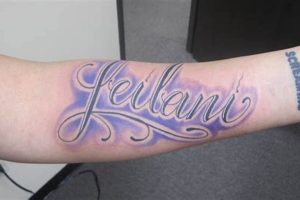A floral motif combined with a name inscription represents a popular choice for personalized body art. This approach allows for a wide range of artistic expression, from simple outlines to intricate, photorealistic depictions. Examples include incorporating a beloved’s name within the petals of a stylized bloom, or entwining a stem around a script rendering of a meaningful moniker. The versatility of the design allows for adaptation to various aesthetics, including traditional, neo-traditional, minimalist, and watercolor styles.
Combining floral imagery with names allows individuals to create deeply symbolic and visually appealing tattoos. Roses, in particular, carry rich cultural significance representing love, beauty, and remembrance, lending added depth to the personalized inscription. This fusion of image and text creates a powerful statement of identity and personal values, offering a lasting tribute to loved ones or a visual representation of cherished memories. The historical prevalence of floral imagery in tattooing underscores its enduring appeal and adaptability to contemporary aesthetics.
The following sections will explore various design elements, stylistic choices, placement considerations, and aftercare recommendations for this type of tattoo. From font selection and color palettes to symbolic interpretations and practical advice, this information will guide readers toward making informed decisions in their pursuit of meaningful and aesthetically pleasing body art.
Tips for Rose and Name Tattoo Designs
Careful planning ensures a visually appealing and meaningful tattoo. Consider these factors before finalizing a design.
Tip 1: Font Selection: Script fonts convey elegance, while block letters offer a bolder statement. The chosen font should complement the overall design and the individual’s personal style. Consider legibility, especially for smaller tattoos.
Tip 2: Rose Variety: Different rose types carry unique symbolic meanings. Research various species (e.g., red for passion, yellow for friendship) to align the imagery with the intended message.
Tip 3: Placement: The body’s contours influence the tattoo’s presentation. Placement should consider the design’s size and shape, as well as personal preferences regarding visibility.
Tip 4: Color Palette: Monochromatic designs offer a classic look, while vibrant colors can enhance visual impact. Color choices can also contribute to the tattoo’s symbolic meaning.
Tip 5: Size and Detail: Intricate details require larger surface areas. Balance the desired level of detail with the chosen placement and overall aesthetic.
Tip 6: Artist Consultation: Collaborate with a reputable tattoo artist. Discuss design ideas, placement options, and any specific concerns to achieve the desired outcome.
Tip 7: Aftercare: Proper aftercare is crucial for preserving the tattoo’s vibrancy and preventing complications. Follow the artist’s instructions diligently.
Careful consideration of these elements ensures a tattoo that resonates with personal meaning and maintains its aesthetic appeal over time. A well-planned design is a testament to individual expression and artistic collaboration.
By understanding these crucial elements, individuals can approach the tattooing process with confidence and ensure a result that is both meaningful and visually striking.
1. Placement (body area)
Tattoo placement significantly influences the overall aesthetic and symbolic meaning of a rose and name design. Consideration of body contours, visibility preferences, and the design’s size and shape are crucial for achieving a harmonious and impactful result.
- Wrist/Forearm
These locations offer prominent or easily concealable placement options, suitable for smaller, delicate designs. The curvature of the forearm can complement a stem’s natural flow, while the wrist provides a canvas for compact floral arrangements intertwined with a name.
- Upper Arm/Shoulder
Larger designs benefit from the increased surface area provided by these areas. A sprawling rose blooming across the shoulder can incorporate a name within its petals or along its stem. The upper arm allows for designs that wrap around the limb, creating a dynamic visual.
- Back/Chest
These broad areas offer significant space for intricate and detailed compositions. A large-scale rose design across the back can integrate a name as a central element or as part of a surrounding motif. The chest provides a canvas for designs closer to the heart, amplifying their symbolic significance.
- Ribcage/Side
These areas offer a more private canvas for designs that follow the body’s natural curves. A delicate rose stem and name can gracefully flow along the ribcage, while the side provides space for vertically oriented designs.
Ultimately, the chosen placement should complement the design’s overall aesthetic and the individual’s personal preferences. Careful consideration of these factors contributes to a tattoo that is both visually appealing and deeply meaningful.
2. Rose type (species, color)
Rose variety selection significantly impacts the symbolic meaning and overall aesthetic of a name tattoo. Specific rose types and colors carry established cultural and historical associations, allowing for a deeper layer of personalization. Careful consideration of these symbolic meanings ensures the chosen rose aligns with the intended message of the tattoo.
- Red Rose
Universally recognized as a symbol of passionate love and romance, the red rose adds an element of intensity and deep affection to name tattoos. Often chosen to commemorate a significant other or a passionate relationship, the vibrant hue creates a visually striking focal point.
- Yellow Rose
Representing joy, friendship, and new beginnings, the yellow rose offers a lighter, more cheerful alternative. Suitable for celebrating platonic relationships or commemorating a period of positive change, its bright color adds a touch of optimism to the design.
- White Rose
Symbolizing purity, innocence, and spirituality, the white rose lends an air of reverence and elegance to the tattoo. Often chosen to honor a child or represent a deep spiritual connection, its delicate beauty creates a sense of timeless grace.
- Black Rose
While often associated with mourning or loss, the black rose can also represent rebellion, strength, and mystery. Its dramatic color adds a touch of intrigue and unconventional beauty, making it a powerful choice for those who embrace non-traditional aesthetics.
By understanding the symbolic meanings associated with different rose varieties and colors, individuals can select a bloom that resonates with the intended message of their name tattoo. This thoughtful selection enhances the design’s personal significance, creating a lasting tribute that reflects both aesthetic preferences and deeply held values.
3. Name style (font, size)
Typographic choices significantly impact the overall aesthetic and legibility of rose name tattoos. Font selection and sizing should complement the chosen rose design, ensuring visual harmony and clear communication of the inscribed name. Careful consideration of these elements contributes to a cohesive and impactful final result.
- Script Fonts
Script fonts, with their flowing, elegant lines, often evoke a sense of classic beauty and romance. These fonts, reminiscent of calligraphy, can be particularly effective for names with long, graceful letterforms. However, highly ornate scripts can become less legible at smaller sizes, requiring careful consideration of placement and scale.
- Block/Gothic Fonts
Block or gothic fonts, characterized by their bold, straight lines, convey strength and permanence. These fonts offer excellent legibility, even at smaller sizes, making them suitable for shorter names or placements with limited space. The strong lines of these fonts can contrast effectively with the delicate curves of a rose design.
- Serif/Sans-serif Fonts
Serif fonts, with their decorative strokes, offer a traditional and often formal aesthetic, while sans-serif fonts, lacking these strokes, provide a more modern and minimalist feel. The choice between serif and sans-serif fonts depends on the overall design aesthetic and the desired level of formality.
- Size and Proportion
The size of the name inscription should be proportional to the rose design and the chosen placement. Larger names may overwhelm smaller rose designs, while smaller names may appear lost within larger, more intricate floral arrangements. Careful scaling ensures visual balance and emphasizes both the name and the accompanying floral imagery.
By considering these typographic elements, individuals can ensure the name inscription complements the chosen rose design and enhances the overall aesthetic of the tattoo. Harmonious integration of font style and size with the floral elements creates a cohesive and impactful visual statement, effectively communicating both personal identity and artistic expression.
4. Composition (arrangement)
Compositional arrangement significantly influences the visual impact and narrative of rose name tattoos. Strategic placement of elementsthe rose, name, and any additional embellishmentscreates a balanced and aesthetically pleasing design. Careful consideration of arrangement ensures the tattoo effectively communicates its intended message while adhering to fundamental design principles.
- Intertwined Elements
Weaving the name within the rose’s petals or along its stem creates a sense of unity and connection. This arrangement symbolizes the deep integration of the name’s significance with the rose’s symbolic meaning. For example, a name nestled within the curves of a blooming rose conveys a sense of intimacy and personal significance.
- Juxtaposed Elements
Placing the name adjacent to the rose, rather than intertwined, offers a distinct yet complementary arrangement. This approach allows each element to stand out while maintaining a visual relationship. For instance, a name positioned beneath a fully bloomed rose can create a caption-like effect, adding a layer of narrative to the design.
- Encircling Arrangements
A name encircling a rose, or vice versa, creates a frame-like effect, drawing attention to the central element. This arrangement symbolizes protection and envelopment, suggesting the name’s importance is paramount. For example, a thorny rose stem encircling a name can represent a cherished memory protected by the passage of time.
- Asymmetrical Balance
Strategic use of asymmetry can create a dynamic and visually engaging composition. Offsetting the name and rose, perhaps with additional elements like leaves or thorns, introduces visual interest and movement. This arrangement can represent growth, change, or the ongoing evolution of a relationship.
Thoughtful compositional arrangement elevates rose name tattoos beyond mere decoration, transforming them into meaningful visual narratives. By considering the interplay between elements and employing established design principles, individuals can create tattoos that resonate with personal significance and artistic expression. A well-composed design ensures the tattoo remains visually appealing and effectively communicates its intended message over time.
5. Color palette (realistic, monochrome)
Color palettes significantly influence the overall mood, aesthetic, and symbolic meaning of rose name tattoos. Careful selection of hues, whether vibrant and realistic or starkly monochrome, contributes to the design’s visual impact and longevity. Understanding the interplay of color and its potential impact on the final result empowers informed decision-making regarding the desired aesthetic and intended message.
- Realistic Color
Realistic color palettes mimic the natural hues of roses, creating a lifelike representation of the flower. This approach allows for a vibrant and visually striking tattoo, often employing shades of red, pink, yellow, or even multi-colored varieties. Realistic color can enhance the three-dimensional quality of the rose, adding depth and realism to the design.
- Monochromatic Grayscale
Monochromatic grayscale palettes utilize varying shades of black and gray to create a timeless and classic aesthetic. This approach emphasizes the rose’s form and texture, offering a subtle yet powerful visual impact. Grayscale palettes also tend to age well, maintaining clarity and definition over time.
- Blackwork
Blackwork utilizes solid black ink to create bold and graphic designs. This approach emphasizes strong lines and contrasts, resulting in a striking visual statement. Blackwork rose tattoos often feature stylized or geometric interpretations of the flower, prioritizing impactful silhouettes over intricate detail.
- Watercolor Effect
The watercolor effect mimics the soft, diffused appearance of watercolor paintings, creating a dreamlike and artistic aesthetic. This approach often uses a blend of vibrant colors with subtle gradients, resulting in a unique and visually captivating tattoo. The watercolor effect can add a sense of fluidity and movement to the rose design.
The chosen color palette interacts with other design elementsrose type, name style, and placementto create a cohesive and meaningful tattoo. A realistic color palette might enhance the romantic symbolism of a red rose, while a monochromatic grayscale palette could emphasize the timeless elegance of a white rose paired with a script font. Ultimately, the selected color palette should align with the individual’s aesthetic preferences and the intended message of the tattoo, ensuring a visually striking and deeply personal piece of art.
6. Additional elements (thorns, leaves)
Incorporating additional elements like thorns and leaves enhances the symbolic depth and visual complexity of rose name tattoos. These seemingly minor additions contribute significantly to the overall narrative and aesthetic of the design. Thorns, often representing protection, resilience, or hidden strength, can add a layer of intrigue and contrast to the delicate beauty of the rose. Leaves, symbolizing growth, renewal, and the cyclical nature of life, can complement the rose’s bloom, creating a sense of wholeness and vitality. The strategic inclusion of these elements allows for a more nuanced and personalized representation of the individual’s chosen message. For instance, a withered leaf alongside a blooming rose and a name might symbolize remembrance or the bittersweet passage of time, while prominent thorns surrounding a name can suggest a fiercely protected love or a guarded heart.
The quantity and placement of these additional elements further influence the tattoo’s overall message. A scattering of leaves around a rose and name can create a sense of natural abundance and growth, while a single, strategically placed thorn might highlight a specific hardship or challenge overcome. Furthermore, these elements offer opportunities for artistic expression through variations in size, shape, and detail. Delicately rendered leaves can evoke a sense of fragility and grace, while boldly illustrated thorns can convey strength and resilience. The interplay between these elements contributes to the visual balance and overall cohesiveness of the tattoo design. For example, thorns intertwined with a name scripted along a rose stem can create a visually striking representation of overcoming adversity, while a cluster of leaves surrounding the bloom and name might symbolize flourishing love or a period of personal growth.
Understanding the symbolic weight and visual impact of additional elements empowers informed decision-making in the design process. Careful consideration of these elements ensures the final tattoo not only adheres to aesthetic preferences but also effectively communicates the intended narrative. The thoughtful incorporation of thorns, leaves, and other embellishments elevates the rose name tattoo beyond a simple image, transforming it into a complex and deeply personal work of art. This attention to detail ensures the design remains visually captivating and symbolically resonant, offering a lasting tribute to cherished memories, relationships, and personal values.
7. Overall style (traditional, minimalist)
The overall stylistic approach significantly influences the final aesthetic and symbolic representation of rose name tattoos. Selecting a cohesive style, whether traditional, minimalist, or another distinct genre, ensures all design elements work harmoniously to convey the intended message. Style dictates the level of detail, color palette, line work, and overall composition, resulting in a tattoo that reflects both personal preferences and artistic sensibilities.
- Traditional (American/Japanese)
Traditional styles, such as American or Japanese, emphasize bold lines, vibrant colors, and iconic imagery. American traditional often features roses with clearly defined petals and bold outlines, paired with names in classic script or block fonts. Japanese traditional, on the other hand, might depict roses with flowing lines and intricate details, often incorporating elements of nature like water or wind, and paired with names rendered in kanji or other stylized scripts. These styles convey a sense of timelessness and classic appeal.
- Minimalist
Minimalist styles prioritize simplicity and clean lines, often using a limited color palette and focusing on essential elements. A minimalist rose name tattoo might feature a single rose outline or a stylized silhouette paired with a name in a simple sans-serif font. This approach emphasizes the core symbolic meaning of the rose and name without unnecessary embellishment, resulting in a subtle yet powerful statement.
- Realism
Realism focuses on achieving a lifelike representation of the rose and name. Realistic rose tattoos often feature intricate shading, detailed petal textures, and lifelike color gradients. Names are typically rendered in script fonts that mimic handwriting or calligraphy, enhancing the personalized nature of the design. This style requires a high level of artistic skill and attention to detail.
- Watercolor
Watercolor styles emulate the soft, diffused aesthetic of watercolor paintings. These tattoos often feature vibrant colors that bleed into one another, creating a dreamlike and artistic effect. Roses are depicted with fluid lines and subtle color transitions, and names are often integrated within the flowing watercolor washes. This style offers a unique and visually captivating approach to rose name tattoo design.
The chosen overall style serves as a unifying factor, ensuring all design elementsrose type, name style, color palette, and additional embellishmentscoalesce into a harmonious and meaningful composition. Selecting a style that resonates with individual preferences and the intended message of the tattoo ensures a final result that is both visually striking and deeply personal. A cohesive style elevates the rose name tattoo from a simple image to a curated piece of art, reflecting individual expression and commemorating cherished values.
Frequently Asked Questions
This section addresses common inquiries regarding rose and name tattoo designs, offering practical insights and clarifying potential concerns.
Question 1: How much do rose and name tattoos typically cost?
Pricing depends on factors such as size, complexity, artist’s experience, and studio location. Obtaining quotes from multiple reputable artists is recommended.
Question 2: What is the best placement for a rose and name tattoo?
Optimal placement depends on individual preferences, design size, and desired visibility. Forearms, upper arms, back, and chest are popular choices.
Question 3: How long does the tattooing process take?
Session duration varies based on design intricacy and size. Smaller, simpler designs may take an hour or two, while larger, more complex pieces can require multiple sessions.
Question 4: What is the typical healing time for this type of tattoo?
Healing generally takes two to three weeks. Adhering to proper aftercare instructions is essential for optimal healing and color retention.
Question 5: Can rose and name tattoos be easily covered up or removed?
Cover-ups and removals are possible but present greater challenges with detailed designs. Laser removal is a viable option, although multiple sessions are often necessary.
Question 6: What are important considerations when choosing a tattoo artist?
Researching an artist’s portfolio, reviewing client testimonials, and confirming proper hygiene practices are crucial steps in selecting a qualified professional.
Careful consideration of these factors contributes to a positive tattooing experience and ensures a result that meets expectations. Consulting with reputable artists and addressing any concerns beforehand is always recommended.
Further information regarding specific design choices and aftercare procedures can be found in the following resources.
Rose Name Tattoo Ideas
Exploration of rose name tattoo designs reveals the multifaceted nature of this popular form of self-expression. From stylistic choices encompassing traditional, minimalist, and realistic approaches to symbolic considerations regarding rose variety, color, and accompanying elements, each facet contributes to the design’s overall impact. Placement, composition, and typographic selection further refine the aesthetic and narrative of the tattoo, transforming it from a simple image into a personalized statement of identity, remembrance, or affection. Careful consideration of these elements, coupled with consultation with experienced and reputable artists, is paramount for achieving a result that resonates with individual values and artistic vision.
The enduring appeal of rose name tattoos underscores the human desire to express profound emotions and personal narratives through the art of permanent body modification. As artistic techniques evolve and cultural interpretations shift, the symbolic richness of the rose, combined with the personalized inscription of a name, will likely continue to inspire meaningful and visually compelling tattoo designs for generations to come. Individuals seeking to embark on this journey of self-expression are encouraged to thoroughly research design options, engage in thoughtful introspection, and prioritize collaboration with skilled artists to ensure a tattoo that reflects not only current aesthetic preferences but also enduring personal significance.







